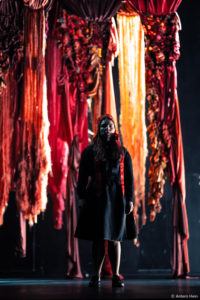Sami Culture: The play and politics of Elle Sofe Sara - Vancouver Ballet Society
- Home
- Features 2020 - 2023
- Sami Culture: The play and politics of Elle Sofe Sara

By Victor Swoboda
The embattled culture of Norway’s Indigenous Sami people is at the heart of work by Elle Sofe Sara, a 39-year-old dancemaker and filmmaker whose presentations over the past several years have alerted European audiences to her people’s history. Her 2021 choreography, Vástádus eana — The answer is land, opens Montreal’s 16-day Festival TransAmériques on May 24. The piece involves three dancers and four singers who perform the age-old Sami chant called yoik. (Check out this short film, Juoigangiehta, The yoiking hand, by Sara.)
Formerly known as Laplanders, a term now in disrepute, Sami live in a territory called Sapmi that encompasses northern parts of Norway, Sweden, and Finland, and a section of Russia. As reindeer and sheep herders as well as coastal fishermen, Sami depend on nature’s bounty for their livelihood; in consequence, they are sensitive to changes that affect the land.

“There’s a Sami tradition of asking the land and its spirits for permission to be present,” explained Sara in fluent English during a Zoom interview from her base in her birthplace of Guovdageaidnu, a village in a municipality with a Sami population of about 3,000. “Usually, we do this in our minds, but in The Answer is land, I’ve put this tradition into the form of a yoik and in choreography. [By staging] this spiritual practice, we bring the performers and the audience together.”
Sara resists being pigeon-holed as a traditional Sami artist. The yoik in The answer is land, for example, was composed by the Norwegian musician Frode Fjellheim as polyphony, which is not part of yoik tradition. Also, she says, “Sami culture has no traditional dance, but there is a formation dance in The answer is land that is a kind of made-up folk dance. Those who don’t know Sami culture think this is a traditional dance, but it’s not. I like to play with people’s assumptions.”
Like many Indigenous people, Sami suffered under assimilation policies. Beginning in the 19th century, the governments of Sweden and Norway forcibly tried to eradicate Sami culture. Sami children were sent to state-run boarding schools. Laws were enacted to forbid the use of Sami language and practices. Commercial interests severely encroached on Sami land.
In more recent times, public demonstrations have been held to protest the treatment of Sami. Sara says that the formation-dance sequences in The answer is land are intended to suggest both demonstration front lines and police counter-offensives.

Sara has been to Canada before, performing in 2013 at the Alianait Arts Festival in Iqaluit, Nunavut. Six years later, she went to Toronto to perform at the SummerWorks Festival for an edition featuring Norwegian artists. Through these experiences, she met many Indigenous people in Canada. “I felt they and the Sami are similar, as are Canada and Norway.”
Although born and raised in a tiny isolated community, Sara was later educated in the wider world. At 16, she moved to the city of Tromsø, a regional cultural hub in Norway where she studied ballet, jazz, and contemporary dance at an arts high school. Three years later, she was accepted at the exclusive Trinity Laban Conservatoire of Music and Dance in London.
“I don’t know what they saw in me. I didn’t express my Sami culture at the audition,” Sara recalled. “But I had a very strong, flexible body that could do a lot of things. I think I was also very open and eager to learn more.”

Along with ballet, Sara studied dance techniques like Limón and release. “It was a big transition. Everything was very new to me. Laban was a huge school, with 20-25 students in each class, and I felt part of a big system. I dove into everything.”
Subsequently, she studied for her master’s degree in choreography at Oslo’s National Academy of the Arts. “At Laban we had to share studios for after-school projects whereas in Oslo I had my own facilities.”
Sara was “really pushed” by her thesis project mentor, the Iranian-Norwegian choreographer Hooman Sharifi. Sharifi’s choreography emphasizes civic engagement and politics, an approach that left its mark on Sara. “I think probably every artwork can be seen as political,” she said. Sara calls The Answer is land “my statement about this broken connection to land and about standing together with others.”
During our interview, Sara noted that a large public demonstration in support of Sami was underway in Oslo. A day earlier, Swedish environmentalist Greta Thunberg was twice detained by Oslo police during demonstrations at Norwegian government offices to demand the removal of wind turbines from Sami reindeer pastures.
Sara is one of several Indigenous artists presenting work at the 2023 Festival TransAmérique. Co-artistic directors Jessie Mill and Martine Dennewald have invited them in the hope of engaging audience feelings about people’s links to nature, land, and cultural history. Sara seems sure to profit from their presence. “If I see interesting work in Montreal, I might say, ‘This is a path I’d like to follow.’ I like to grab opportunities.”

